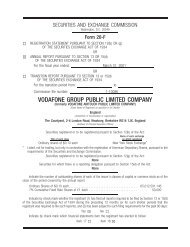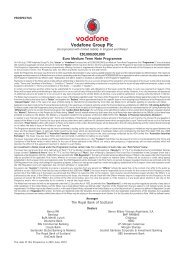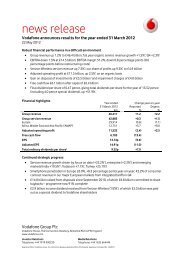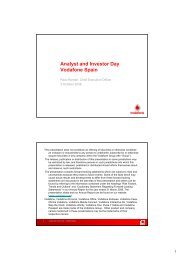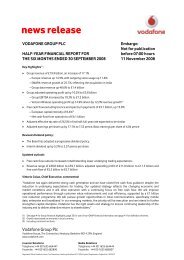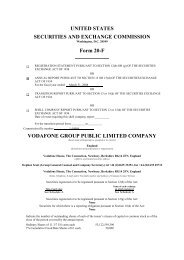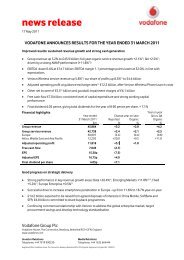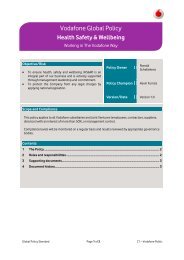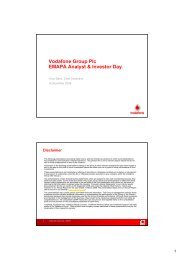Create successful ePaper yourself
Turn your PDF publications into a flip-book with our unique Google optimized e-Paper software.
<strong>Vodafone</strong> – Performance<br />
Operating Results continued<br />
Adjusted operating profit<br />
The impact of acquisitions, disposal and exchange rates on adjusted operating<br />
profit is shown below.<br />
Impact of Impact of<br />
exchange acquisitions<br />
Organic rates and disposal (1) Reported<br />
growth Percentage Percentage growth<br />
% points points %<br />
Adjusted operating profit<br />
Eastern Europe 49.2 (7.6) (37.1) 4.5<br />
Middle East, Africa and Asia 18.5 (16.9) 31.1 32.7<br />
Pacific 25.4 (11.8) – 13.6<br />
EMAPA 27.4 (8.7) (1.3) 17.4<br />
Note:<br />
(1) Impact of acquisitions and disposal includes <strong>the</strong> impact of <strong>the</strong> change in consolidation status<br />
of Bharti Airtel from a joint venture to an investment.<br />
Adjusted operating profit increased by 17.4%. On an organic basis, growth was 27.4%,<br />
as <strong>the</strong> acquisitions and stake increases led to <strong>the</strong> rise in acquired intangible asset<br />
amortisation reducing <strong>report</strong>ed growth in operating profit. These acquisitions,<br />
combined with <strong>the</strong> continued expansion of network infrastructure in <strong>the</strong> region,<br />
including 3G and HSDPA upgrades, resulted in higher depreciation charges.<br />
Organic growth in adjusted operating profit was driven by a strong performance<br />
in Romania, Egypt, South Africa and <strong>the</strong> Group’s associated undertaking in <strong>the</strong> US.<br />
Eastern Europe<br />
Interconnect costs increased by 46.3%, or 23.8% on an organic basis, principally<br />
as a result of <strong>the</strong> higher usage in Romania. An ongoing regulatory fee in Turkey<br />
amounting to 15% of revenue increased o<strong>the</strong>r direct costs compared to <strong>the</strong> 2006<br />
financial year.<br />
Acquisition costs fell as a percentage of service revenue throughout most of<br />
Eastern Europe, with increased investment in <strong>the</strong> direct distribution channel in<br />
Romania resulting in lower subsidies on handsets. Retention costs decreased as<br />
a percentage of service revenue, but increased on an organic basis due to a focus<br />
on retaining customers through loyalty programmes in response to <strong>the</strong> increasing<br />
competition in Romania, which had a positive impact on contract and prepaid churn.<br />
Operating expenses increased by 1.0 percentage point as a percentage of service<br />
revenue, primarily as a result of inflationary pressures in Romania and investment<br />
in Turkey.<br />
Middle East, Africa and Asia<br />
Interconnect costs increased by 45.0%, or 26.8% on an organic basis, due to <strong>the</strong><br />
usage stimulation initiatives throughout <strong>the</strong> region.<br />
Acquisition costs remained stable as a percentage of service revenue, while<br />
retention costs increased, principally due to increased investment in retaining<br />
customers in Egypt ahead of <strong>the</strong> launch of services by a new operator after<br />
31 March 2007 and in South Africa in response to <strong>the</strong> introduction of mobile<br />
number portability during <strong>the</strong> 2007 financial year, with <strong>the</strong> provision of 3G and<br />
data enabled device upgrades for contract customers and a loyalty point scheme.<br />
Operating expenses remained stable as a percentage of service revenue.<br />
Pacific<br />
The improved profitability in Australia was more than offset by <strong>the</strong> lower<br />
profitability in New Zealand resulting from <strong>the</strong> increased cost of telecommunications<br />
service obligation regulation, <strong>the</strong> impact of <strong>the</strong> acquisition of ihug and adverse<br />
foreign exchange rates.<br />
Acquisition and retention costs increased as a percentage of service revenue<br />
due to <strong>the</strong> investment in higher value customers in Australia, which also had<br />
a favourable impact on contract churn and were partially offset by savings in<br />
network costs and operating expenses.<br />
50 <strong>Vodafone</strong> Group Plc Annual Report 2008<br />
Associates<br />
2007 % change<br />
Verizon Verizon<br />
Wireless O<strong>the</strong>r Total Wireless<br />
Share of result of associates £m £m £m £ $<br />
Operating profit 2,442 167 2,609 15.6 22.9<br />
Interest (179) 2 (177) (12.3) (7.0)<br />
Tax (125) (39) (164) 7.8 14.6<br />
Minority interest (61) – (61) 1.7 6.7<br />
2,077 130 2,207 19.9 27.6<br />
2006<br />
Verizon<br />
Wireless O<strong>the</strong>r Total<br />
Share of result of associates £m £m £m<br />
Operating profit 2,112 263 2,375<br />
Interest (204) 1 (203)<br />
Tax (116) (72) (188)<br />
Minority interest (60) – (60)<br />
1,732 192 1,924<br />
% change<br />
Verizon Wireless (100% basis) 2007 2006 £ $<br />
Total revenue (£m) 20,860 18,875 10.5 17.4<br />
Closing customers (’000) 60,716 53,020<br />
Average monthly ARPU ($) 52.5 51.4<br />
Blended churn 13.9% 14.7%<br />
Mobile non-voice service<br />
revenue as a percentage of<br />
mobile service revenue 14.4% 8.9%<br />
Verizon Wireless produced ano<strong>the</strong>r year of record growth in organic net additions,<br />
increasing its customer base by 7.7 million in <strong>the</strong> year ended 31 March 2007.<br />
The performance was particularly robust in <strong>the</strong> higher value contract segment<br />
and was achieved in a market where <strong>the</strong> estimated closing mobile penetration<br />
reached 80%.<br />
The strong customer growth was achieved through a combination of higher gross<br />
additions and improvements in Verizon Wireless’ customer loyalty, with <strong>the</strong> latter<br />
evidenced through lower levels of churn. The 15.4% growth in <strong>the</strong> average mobile<br />
customer base combined with a 2.1% increase in ARPU resulted in a 17.8%<br />
increase in service revenue. ARPU growth was achieved through <strong>the</strong> continued<br />
success of data services, driven predominantly by data cards, wireless email and<br />
messaging services. Verizon Wireless’ operating profit also improved due to<br />
efficiencies in o<strong>the</strong>r direct costs and operating expenses, partly offset by a higher<br />
level of customer acquisition and retention activity.<br />
Verizon Wireless continued to lay <strong>the</strong> foundations for future data revenue growth<br />
through <strong>the</strong> launch of both CDMA EV-DO Rev A, an enhanced wireless broadband<br />
service, and broadcast mobile TV services during <strong>the</strong> first calendar quarter of<br />
2007. In addition, Verizon Wireless consolidated its spectrum position during<br />
<strong>the</strong> year with <strong>the</strong> acquisition of spectrum through <strong>the</strong> Federal Communications<br />
Commission’s Advanced Wireless Services auction for $2.8 billion.<br />
The Group’s share of <strong>the</strong> tax attributable to Verizon Wireless for <strong>the</strong> year ended<br />
31 March 2007 relates only to <strong>the</strong> corporate entities held by <strong>the</strong> Verizon Wireless<br />
partnership. The tax attributable to <strong>the</strong> Group’s share of <strong>the</strong> partnership’s pre-tax<br />
profit is included within <strong>the</strong> Group tax charge.<br />
The Group’s o<strong>the</strong>r associated undertakings in EMAPA have been impacted by<br />
intense competition and reduction in termination rates, similar to <strong>the</strong> experiences<br />
of <strong>the</strong> Group’s controlled businesses in <strong>the</strong> Europe region, which have had a<br />
negative impact on revenue. The Group disposed of its associated undertakings<br />
in Belgium and Switzerland on 3 November 2006 and 20 December 2006,<br />
respectively, for a total cash consideration of £3.1 billion. Results are included<br />
until <strong>the</strong> respective dates of <strong>the</strong> announcement of disposal.




